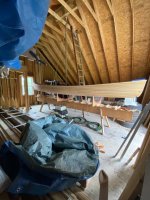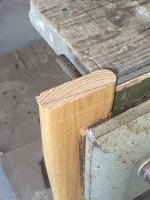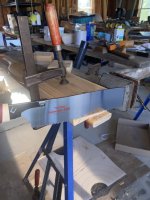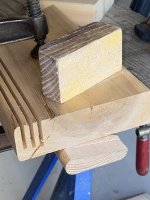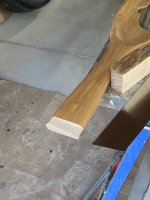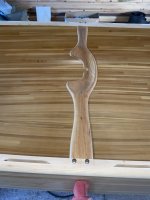-
Happy Mathematics Day! ❌📐♾️
You are using an out of date browser. It may not display this or other websites correctly.
You should upgrade or use an alternative browser.
You should upgrade or use an alternative browser.
First Build: 17'-6" J. Winters "Yukon"
- Thread starter RickR
- Start date
I would shape a re reinforcement going across that glue joint, if you are going to use it as a carryt handle. Stressing a glue joint like that is not a good idea IMO.
Brian
Brian
Good point Brian.
Jim
Jim
Thank you Brian and Jim for your thoughts on the book match deck glue joints. I pondered on them a bit before proceeding as I did. “CanoeCraft” actually shows a spline at that location, but I thought that overkill. I used Titebond 3 for those joints and had good fits and clamp pressure. I’m planning to use epoxy when I install to the inwales.
I think about the “carry” load on the decks in the context of the overall assembly, not just the book match joint. Grain orientation for glue is ideal at the inwale joints. The inwales are rock solid, glued to the hull and rabetted outwale. The wide points of the decks are short (5 1/2 inches bow and 6 3/8 stern) so the span is short. And the load is light. I’m guessing the canoe will end up in the 60-65 pound range.
I’m going to go with what I have and see what happens. The consequence of failure is not high and I know I could fix it.
I appreciate your taking the time to make suggestions. You both have far more experience than I!
Rick
I think about the “carry” load on the decks in the context of the overall assembly, not just the book match joint. Grain orientation for glue is ideal at the inwale joints. The inwales are rock solid, glued to the hull and rabetted outwale. The wide points of the decks are short (5 1/2 inches bow and 6 3/8 stern) so the span is short. And the load is light. I’m guessing the canoe will end up in the 60-65 pound range.
I’m going to go with what I have and see what happens. The consequence of failure is not high and I know I could fix it.
I appreciate your taking the time to make suggestions. You both have far more experience than I!
Rick
Seats are going in and it feels like the finish line is in sight. I made a scribing jig out of scrap lumber for the rear seat. Once it was positioned and supported I scribed one rail at a time and when satisfied with the fit screwed it to the jig. After transferring the long point of each cut to the seat (place and trace) I used the jig rail ends to guide a pull saw. One of the happy surprises of this build has been that hand tools have often been appropriate and even preferable. I like hand tools.
I ended up using 1/4 inch stainless steel carriage bolts for seat attachments after no luck finding 3/16 in the lengths I needed (4 to 7 inches). I doubt they’ll break! I have #10 carriage bolts for thwarts, much more appropriate to scale and function. I ended up using northern white cedar for seat drops. I still need to profile them when I disassemble for finishing.



I ended up using 1/4 inch stainless steel carriage bolts for seat attachments after no luck finding 3/16 in the lengths I needed (4 to 7 inches). I doubt they’ll break! I have #10 carriage bolts for thwarts, much more appropriate to scale and function. I ended up using northern white cedar for seat drops. I still need to profile them when I disassemble for finishing.




That looks great and I love the sculpted thwart. Well worth the effort.
Jim
Jim
The plans call for an adjustable bow seat which I fully intended to ignore. But not having experience with an asymmetrical hull, having no idea where to place a fixed bow seat, and not having deviated from the plans so far, I went for it. The Yukon is a tripping canoe and we know how to trim with our load. But as we age we are increasingly enjoying base camping. Day trips from base camp are without load to trim with. Sometimes we have our dog who’s always in front of the bow seat. If we end up hating the adjustable seat at least we’ll have real world experience to place a fixed one.
I found installing slide rails plumb, level, square and equidistant from centerline a fussy, time consuming process. I ended up building with scrap wood to work everything out. The rails are 3/4 wide by 1 inch tall and tight grain, quarter sawn ash. I have high hopes for them staying straight! I elected to dado (13/16 inch wide) the seat rails 3/8 inch deep to accommodate the slide rails and still need to fashion “keepers” of some sort to secure the seat to the rails. I mocked up a test seat to verify function which is smooth and easy. I just wish the whole thing wasn’t so ugly!





I found installing slide rails plumb, level, square and equidistant from centerline a fussy, time consuming process. I ended up building with scrap wood to work everything out. The rails are 3/4 wide by 1 inch tall and tight grain, quarter sawn ash. I have high hopes for them staying straight! I elected to dado (13/16 inch wide) the seat rails 3/8 inch deep to accommodate the slide rails and still need to fashion “keepers” of some sort to secure the seat to the rails. I mocked up a test seat to verify function which is smooth and easy. I just wish the whole thing wasn’t so ugly!





In the Winisk and the Quetico, a couple of other J. Winters' designs. I usually fixed the seats in, and quite a bit back to, I think around 60 inches from the bow to the front of the seat. The bows of those two canoes were quite narrow, so having the seats that far back provided ample leg room for most people. The Dumoine and the Yukon would be far more forgiving, given the generous and buxom dimensions, and could probably handle a fixed seat quite a bit more bow forward.
Given your fine wood working skills, a sliding seat is a great idea!
Given your fine wood working skills, a sliding seat is a great idea!
Thanks Mem! I was surprised when I started locating seats and thwarts how far back the bow seat is located and how much canoe length an adjustable seat requires. Although the Yukon is a foot and a half longer than our 16 foot Mad River Explorer the cargo area between the bow and stern seats is essentially the same. The Yukon is a bit wider and deeper. I think the functional carrying capacity of the two is similar and hope the paddling characteristics of the Yukon are superior. I'm pretty sure it won't oil can without a load like our Explorer does!
The decks are installed and all that’s left is varnishing the exterior and applying tung oil to the gunnels. I made Jim Dodd style drain holes at the stems. I was happy with the inwale to deck fits so ended up using Titebond 3 instead of epoxy. While dry running my clamp strategy for stern deck glue up I heard a pop. The inner stem cracked! I was surprised, but it makes sense. Deck shape is a pretty good wedge. When clamp pressure released the crack closed back tight. I was thinking that epoxy might be a good way to seal stem end grain…



I've used epoxy to glue cracks.
- Joined
- Apr 20, 2022
- Messages
- 258
- Reaction score
- 491
Absolutely beautiful work!
I was curious to see how far the actual balance point deviated from the theoretical balance point. The plans call for the carry thwart to be 8’-6” from the stern, 9’ from the bow (asymmetrical hull). Even with the adjustable bow seat all the way back it was bow heavy at that location. Adding my PFD to the stern seat balanced the boat nicely. Easy enough, so I installed at the plan location.
I like to portage bow high. It’s easier to see where I’m going. I installed the carry yoke at a 7 degree angle so that when I’m carrying the yoke is parallel with the ground. I’ve always disliked the sensation of the yoke sliding back off my shoulders during a carry. Hopefully this will help.
I like to portage bow high. It’s easier to see where I’m going. I installed the carry yoke at a 7 degree angle so that when I’m carrying the yoke is parallel with the ground. I’ve always disliked the sensation of the yoke sliding back off my shoulders during a carry. Hopefully this will help.
Attachments
- Joined
- Aug 10, 2018
- Messages
- 2,052
- Reaction score
- 6,835
I really like the idea of angling the carry thwart... have you done that before or is it experimental?
I too like the majority of the weight behind me when portaging. It's much less tiring to pull down on the boat (in front of you) than to hold it up.
I too like the majority of the weight behind me when portaging. It's much less tiring to pull down on the boat (in front of you) than to hold it up.
This is my first build and it's experimental. If I don't like it I can easily change it with a shim or more hand tool work. I've always wondered why carry yokes are typically installed parallel to the canoe when canoes are seldom carried parallel to the ground. Perhaps I'll find out!
Like mine angled as well, although I tend to make the yoke lighter and then add a wedge at the sides.
Brian
Brian
I prefer a neutral balance, so the canoe will balance on my shoulders without holding it.
I like to run the bow line to the stern so that it droops to where my hands are when my arms are down. That way I can correct for out of balance issues with the line without having to hold the canoe. I don't like to have to hold the canoe during a carry either.I prefer a neutral balance, so the canoe will balance on my shoulders without holding it.
Similar threads
- Replies
- 161
- Views
- 11K
- Replies
- 14
- Views
- 916
- Replies
- 78
- Views
- 10K
- Replies
- 81
- Views
- 11K
- Replies
- 23
- Views
- 5K




